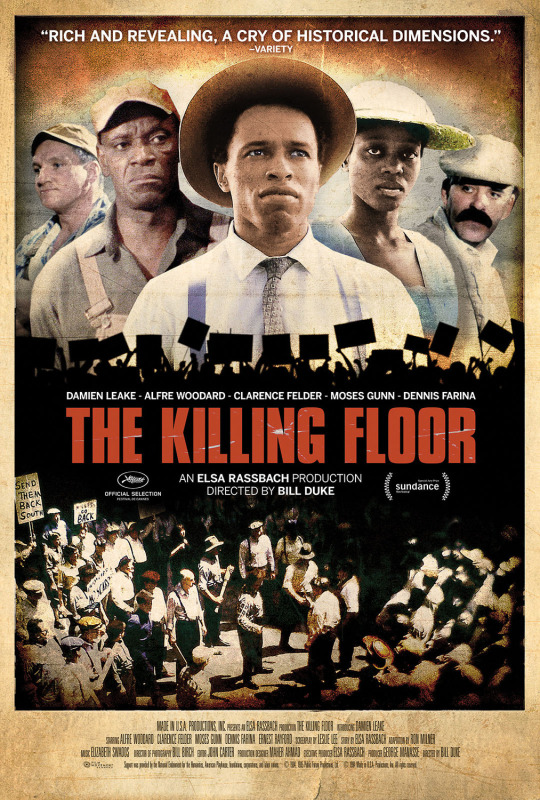#ErnestRayford
Explore tagged Tumblr posts
Text
Thoughts : The Killing Floor (1984)

Bill Duke could have acted his entire career and been fine. With an imposing figure, a dignified manner and a controlled ferocity that leaped off the screen due to his supremely natural acting chops, his acting career has spanned nearly 45 years. After a couple of acting roles, however, Bill Duke caught the directing bug, and prior to stepping into his role for Commando, he did something about it, resulting in his directorial debut : the made for television film and historical drama The Killing Floor.
With America’s involvement in World War I, jobs in the midwestern and northern regions of the United States opened up, resulting in a migration of the Black workforce from the south who were seeking opportunity. Among these individuals are Frank Custer (Damien Leake) and Thomas Joshua (Ernest Rayford), childhood friends from Mississippi that hopped a train to Chicago in search of employment with the hopes of bringing their families along down the road. The pair land employment in the Chicago stockyards, but very early on, the two learn that the same bigotry and racism they attempted to escape is alive and well in their new home. Thomas leaves for the military, and Frank finds himself involved in Union matters, which puts him in the good graces of Amalgamated Meat Cutters & Butcher Workmen of North America Union leader Bill Bremer (Clarence Felder), and firmly in the crosshairs of Heavy Williams (Moses Gunn). Frank manages to bring his wife Mattie (Aflre Woodard) and family to Chicago, but issues quickly escalate, turning what was a Union matter into a full scale race riot between the citizens of Chicago.
It is incredibly impressive how well that Bill Duke was able to handle so many lofty subjects in a directorial debut. As a piece of historical entertainment, it must be noted how much respect the Union representation is given in the film, albeit not one absent of flaws. Much of the cultural heritage that fuels the energy and concentrated focus of a Union is also put on display, which helps to broaden the perspective of the world presented. Media also has a tendency to paint this era of America in absolutes when it comes to racism, as if the south was a cespool and the north was a safe haven, so it is refreshing to see a representation of the strife that existed in these northern cities given fair examination. Though not a main focus, the cross-pollination of both diverse cultures and regional cultures also has a presence in the film.
Many of these same aspects are also deeply mined for their dramatic aspects to a great effect. The presence of the Union within the story becomes a still force in a moving current, not only causing conflicts to arise among coworkers, but among those within the same races that fall on opposing sides of the Union. This is echoed when it comes to racial and bigotry-based issues, as the only questionable language present in the film are racial slurs, and a consistent aggression is shown towards the Black citizens of Chicago in spite of the opposition being given their Slavic, Polish, and German heritage designations (and so on). The common thread that seems to both unify all involved and separate those fighting is the need to make a living, support those you love, and exist without the fear of attack simply based on the fact that you do exist.
Although there are not a lot of cinematic camera moves, the film does not feel like a made for television affair (even though the aspect ratio is a reminder). The juxtaposition of dramatic footage, historical stock footage and documentary-level footage of the killing floors helps us compartmentalize the many moving parts of the narrative, while also giving us tonal cues as viewers on how to process the information. Music is a living, breathing and thriving part of the film, but it is used in a natural, diegetic manner so as to not distract from the main story. The vast amount of historical research and numerous rewrites shines through in the final product, with incredible nuance being given to deep detail in most every important story beat and element.
Damien Leake is able to channel the tension caused by trying to remain dignified and whole in the face of racial strife that threatens your livelihood and existence, with each circumstance piled on resulting in a tightening coil that threatens to pop at any minute. Alternately, Ernest Rayford channels his tension as action, with his rage manifesting in a growing unhinged nature that makes him more menacing with each appearance. Clarence Felder is able to capture the energy of a man caught between several sides that, if turned against him, could symbolically and literally squash him from existence, all the while holding the banner of betterment for his fellow man regardless of race. Moses Gunn goes the complete inverse route, standing as a full antagonist with hopes of conquering by division, be it through subversive misinformation or outright aggression. Alfre Woodard plays peacemaker and chose innocent, all in the hopes that the soft approach can ease the tension of the world she is suddenly thrust into. Appearances by Cynthia Baker, Dennis Farina, Ted Levine and a host of others fill out the expansive cast.
I’ve seen a few of Bill Duke’s more well known films, such as A Rage in Harlem, Sister Act 2 : Back in the Habit and Hoodlum, but somehow I had no knowledge of The Killing Floor. Discovering this film was a complete pleasure, and I am thankful for The Criterion Collection for preserving the work of creators such as this, as quite often they end up lost to time.
#ChiefDoomsday#DOOMonFILM#BillDuke#LeslieLee#ElsaRassbach#TheKillingFloor#DamienLeake#MosesGunn#AlfreWoodard#ErnestRayford#CynthiaBaker#ClarenceFelder#DennisFarina#TedLevine#JohnMahoney
0 notes